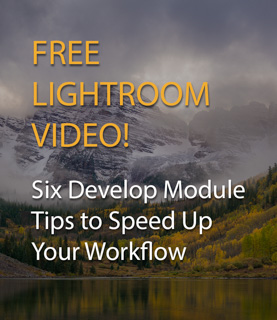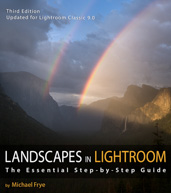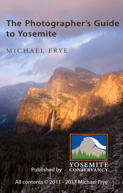In the Moment:
Michael Frye's Landscape Photography Blog
by Michael Frye | Aug 1, 2009 | Announcements

My next exhibit at
The Ansel Adams Gallery, called
Color, Light, and Form, will be on display from August 20th through October 4th. A reception for the artist – yes, that’s me – will be held on Friday, August 28th, from 3:30 to 5:30 p.m. The Gallery is located next to the Visitor Center in Yosemite Valley. Hope to see you there!
We’re still designing the show, so I don’t know exactly which images will be displayed, but there will be a lot of new work, almost certainly including Late October Aspens, June Lake Loop, above. Let me know if you have a particular favorite, old or new, that you’d like to see.
by Michael Frye | Jul 22, 2009 | Yosemite Photo Conditions
 The Tioga Road passes several beautiful lakes, including tiny Siesta Lake, Tenaya Lake, and, just outside the park, Tioga and Ellery Lakes. Short hikes can bring you to May Lake, Elizabeth Lake, Dog Lake, Gaylor Lakes, or Granite Lakes. East of Tioga Pass you can hike to Shell and Fantail Lakes, or take a boat taxi across manmade Saddlebag Lake to Greenstone Lake, Steelhead Lake, and all the other bodies that comprise the Twenty Lakes Basin.
The Tioga Road passes several beautiful lakes, including tiny Siesta Lake, Tenaya Lake, and, just outside the park, Tioga and Ellery Lakes. Short hikes can bring you to May Lake, Elizabeth Lake, Dog Lake, Gaylor Lakes, or Granite Lakes. East of Tioga Pass you can hike to Shell and Fantail Lakes, or take a boat taxi across manmade Saddlebag Lake to Greenstone Lake, Steelhead Lake, and all the other bodies that comprise the Twenty Lakes Basin.
Out of this long list, Middle Gaylor is one of my favorites, along with Shell and Fantail. Another great spot is Greenstone Lake, shown above in mid-July 2006, at the east end of the Saddlebag Lake taxi. But all these places provide great photo opportunities, and relief from the summer heat in the lowlands.
by Michael Frye | Jul 9, 2009 | Announcements, Workshops
 Monday’s Full Moon Night Photography Workshop proved to be a lot of fun. After dodging mosquitos at Tenaya Lake we headed to Olmsted Point and it’s photogenic collection of junipers—perfect subjects to light up at night. I demonstrated some light-painting techniques using simple flashlights, then the students set off to try it on their own. They took to it like ducks to water! It was fun to see people collaborating. Often two or three people would frame a view of the same tree and take turns handling the flashlights, discussing the results after each exposure. Digital cameras certainly make the learning curve much easier.
Monday’s Full Moon Night Photography Workshop proved to be a lot of fun. After dodging mosquitos at Tenaya Lake we headed to Olmsted Point and it’s photogenic collection of junipers—perfect subjects to light up at night. I demonstrated some light-painting techniques using simple flashlights, then the students set off to try it on their own. They took to it like ducks to water! It was fun to see people collaborating. Often two or three people would frame a view of the same tree and take turns handling the flashlights, discussing the results after each exposure. Digital cameras certainly make the learning curve much easier.
This outstanding photograph was made by one of the participants, Kyle Jones. Clearly Kyle is a quick learner and a talented photographer.
by Michael Frye | Jun 27, 2009 | Photography Tips

In my post from May 22nd (“Tioga Pass is Open”) I talked about how telephoto lenses can flatten perspective and create abstract patterns. Wide-angle lenses are perfect for creating the opposite effect—a sense of depth in a flat, two-dimensional photograph.
Wide-angle lenses make everything look smaller and further away. They also expand space—they make objects look further apart than normal. You can take advantage of this by exaggerating the size difference between foreground and background to create an illusion of depth. You must get close to something in the foreground, as I did with the rock strata in this photo from Zion—otherwise everything will look small and distant. It also helps to include converging lines, like those in the foreground rocks, to create a sense of perspective. Often a vertical orientation works better than horizontal as you can include a bigger sweep of the foreground.
by Michael Frye | Jun 16, 2009 | Announcements, Workshops

There’s still space available in my Full Moon Night Photography Workshop on July 6th.
I’ve been interested in night photography for a long time, and have created a rather surreal body of nighttime images using flash and flashlights to illuminate objects in the dark. If you haven’t seen this work you can view the
nighttime portfolio on my web site. The techniques required to make such complex photos take years to master, but this one-day workshop is a good introduction to this fun and creative arena of photography. I haven’t taught many classes on this subject, so this is a rare opportunity to learn some of the essential skills needed to make nighttime photographs. To register or get more information
visit The Ansel Adams Gallery’s web site.
by Michael Frye | Jun 15, 2009 | Yosemite Photo Conditions
 Yosemite weather has been unusually cool and wet for the past two or three weeks. It’s not uncommon to see afternoon thunderstorms in the summer, but it is highly unusual for it to rain almost every afternoon for close to three weeks this time of year. It makes me wonder how this moisture will affect the wildflowers. I have to believe it will help them, but since I’ve never seen this much rain before in early June it’s hard to say.
Yosemite weather has been unusually cool and wet for the past two or three weeks. It’s not uncommon to see afternoon thunderstorms in the summer, but it is highly unusual for it to rain almost every afternoon for close to three weeks this time of year. It makes me wonder how this moisture will affect the wildflowers. I have to believe it will help them, but since I’ve never seen this much rain before in early June it’s hard to say.
Summer is usually the peak wildflower season in the Yosemite high country. Although early bloomers like shooting stars appear in June, flowers are typically most abundant in July at elevations between 7000 and 9000 feet. Heavy snow the previous winter can push this peak back into August. This past winter brought average snowfall, so I’d usually expect an average amount of flowers with the peak in July, but the cool and wet weather might delay the bloom and maybe, just maybe, make the flowers more abundant than usual.
The photograph above was made near White Wolf in July of 2004 after slightly below average winter snowfall.
by Michael Frye | Jun 8, 2009 | Announcements, Workshops
 My Hidden Yosemite Valley workshop with The Ansel Adams Gallery ended yesterday. This is the fifth year I’ve done this class, but the first time we based it in Yosemite Valley. In previous years we stayed in Lee Vining in July and photographed the Yosemite high country, but decided to try something different and concentrate on Yosemite Valley this time.
My Hidden Yosemite Valley workshop with The Ansel Adams Gallery ended yesterday. This is the fifth year I’ve done this class, but the first time we based it in Yosemite Valley. In previous years we stayed in Lee Vining in July and photographed the Yosemite high country, but decided to try something different and concentrate on Yosemite Valley this time.
The weather was rather unusual for June. A low pressure system brought rain and high-elevation snow, closing Tioga Pass briefly on Friday. But in between the showers we had some great photo opportunities—sunbeams on Bridalveil Fall Wednesday, chiaroscuro light and clouds from Glacier Point and Sentinel Dome on Thursday, the sun breaking through late Friday to light Bridalveil and Half Dome, and misty meadows Sunday morning. I told the group yesterday that they had the best light and weather of any workshop I’ve led. We even got to photograph two bears on Friday!
We had a nice group of people, and had a great time. The photo above shows John on Sentinel Dome Thursday afternoon.
by Michael Frye | May 29, 2009 | Yosemite Photo Conditions
 Many people assume that once Memorial arrives Yosemite Valley will be overrun with tourists until after Labor Day. Sure, summer is the most crowded season in Yosemite. But there’s a little window between Memorial and the middle of June, the date most kids get out of school, when the valley is still relatively quiet. It’s actually a great time of year in the park. The roads to Tioga Pass and Glacier Point are usually open (as they are now), the waterfalls are still full—in fact often at their peak in early June—and the valley wildflowers are most abundant. The accompanying photo shows Cook’s Meadow with blooming cow parsnip in early June.
Many people assume that once Memorial arrives Yosemite Valley will be overrun with tourists until after Labor Day. Sure, summer is the most crowded season in Yosemite. But there’s a little window between Memorial and the middle of June, the date most kids get out of school, when the valley is still relatively quiet. It’s actually a great time of year in the park. The roads to Tioga Pass and Glacier Point are usually open (as they are now), the waterfalls are still full—in fact often at their peak in early June—and the valley wildflowers are most abundant. The accompanying photo shows Cook’s Meadow with blooming cow parsnip in early June.
by Michael Frye | May 22, 2009 | Announcements, Yosemite Photo Conditions
 Tioga Pass opened Wednesday, and we now have easy access to some of my favorite Yosemite locations: Tenaya Lake, Tuolumne Meadows, and Tioga Pass. I haven’t been up there yet, but usually when the pass first opens there’s still a lot of snow on the peaks near Tioga Pass, and ice on some of the lakes, making for some interesting photo opportunities. I made this image of melting ice and reflections near Gaylor Lakes (a short but steep hike from Tioga Pass) in 2006.
Tioga Pass opened Wednesday, and we now have easy access to some of my favorite Yosemite locations: Tenaya Lake, Tuolumne Meadows, and Tioga Pass. I haven’t been up there yet, but usually when the pass first opens there’s still a lot of snow on the peaks near Tioga Pass, and ice on some of the lakes, making for some interesting photo opportunities. I made this image of melting ice and reflections near Gaylor Lakes (a short but steep hike from Tioga Pass) in 2006.
This photograph is a good example of telephoto compression. Long lenses compress space and make objects look closer together than they really are. This is a good way to create abstract patterns, as in this image where the ice at the top of the frame is actually much farther from the camera than the ice at the bottom, but the visual impression is a flat, abstract design.
by Michael Frye | May 21, 2009 | Photography Tips
Charles Cramer is a master digital printer, and has probably forgotten more about Photoshop than most of us will ever know. He just made an excerpt from his Photoshop booklet—the handout he uses for his highly regarded workshops—available as a PDF download. If you’re serious about making great digital prints you should read this! And while you’re at it you can check out his beautiful photographs.
 My next exhibit at The Ansel Adams Gallery, called Color, Light, and Form, will be on display from August 20th through October 4th. A reception for the artist – yes, that’s me – will be held on Friday, August 28th, from 3:30 to 5:30 p.m. The Gallery is located next to the Visitor Center in Yosemite Valley. Hope to see you there!
My next exhibit at The Ansel Adams Gallery, called Color, Light, and Form, will be on display from August 20th through October 4th. A reception for the artist – yes, that’s me – will be held on Friday, August 28th, from 3:30 to 5:30 p.m. The Gallery is located next to the Visitor Center in Yosemite Valley. Hope to see you there!
















